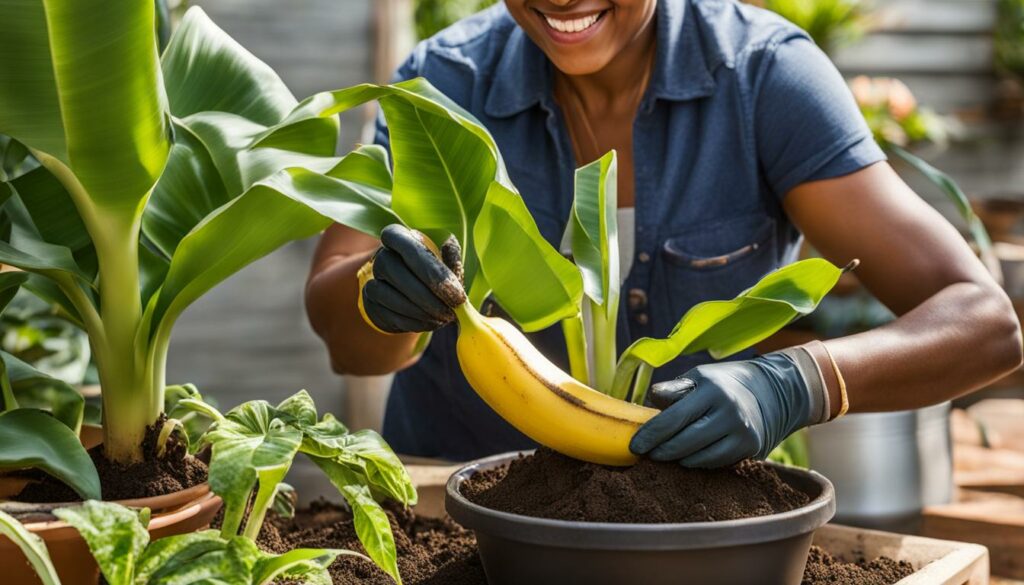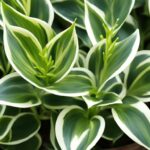Variegated banana plants can bring a touch of tropical beauty to your indoor space. In this Variegated Banana Plant Care Guide, we will explore the necessary steps to care for these plants and ensure their health and vitality. From choosing the right soil and pot to providing proper lighting and humidity, we will cover all aspects of caring for variegated banana plants indoors.
Whether you’re a beginner or an experienced plant enthusiast, our guide will provide you with the essential information you need to keep your variegated banana plants thriving. So let’s dive in and learn how to care for these beautiful plants!
Popular Variegated Banana Plants for Your Indoors
When it comes to adding a touch of tropical beauty to your indoor space, popular variegated banana plants are an excellent choice. These plants not only bring vibrant colors and lush foliage but are also relatively easy to care for. Here are some popular variegated banana plant varieties that you can consider growing indoors:
- Dwarf Cavendish: Known for its compact size, Dwarf Cavendish is a popular choice for indoor gardening. It typically grows to a height of 3 to 4 feet and features beautiful variegated leaves.
- Musa Aeae: Musa Aeae, also known as the “Rainforest Banana,” is a stunning variegated banana plant with unique red and green foliage. It can grow up to 6 to 8 feet in height, adding a dramatic touch to any indoor space.
- Musa Florida: Musa Florida is another popular variety of variegated banana plant. It is known for its large and broad leaves that showcase beautiful white and green variegation. This variety can reach a height of 6 to 8 feet.
- Dwarf Nam Wah: Dwarf Nam Wah is a compact variegated banana plant that reaches a height of about 5 to 6 feet. It features broad leaves with striking variegation, making it a great choice for smaller indoor spaces.
Each of these variegated banana plant varieties has its own unique characteristics and growth patterns. Consider the available space in your home and the desired size of the plant when selecting the right variety for your indoor garden.
How To Plant a Variegated Banana Plant?
Planting a variegated banana plant requires careful consideration of the soil and pot selection. The right soil mix is crucial to ensure the plant’s growth and overall health. It should be well-draining and slightly acidic, with a pH of 5.5 to 6.5. To improve drainage, you can add sand, perlite, and coco-coir to the soil mix. This will help prevent waterlogging and root rot.
When choosing a pot for your variegated banana plant, opt for a tall and deep container. The pot should be able to accommodate the plant’s large leaves and fleshy stalk without restricting its growth. It’s important to choose a pot with drainage holes to allow excess water to escape. This will prevent water buildup and ensure the roots are not sitting in overly moist soil.
Once you have selected the right soil and pot, follow these steps to plant your variegated banana plant:
- Carefully remove the plant from its current container, being cautious not to damage the roots.
- Place a layer of soil at the bottom of the new pot to ensure proper drainage.
- Position the plant in the center of the pot, ensuring it is straight and upright.
- Add soil to fill in around the roots, gently pressing it down to eliminate air pockets.
- Water the plant thoroughly, allowing the water to seep through the drainage holes and saturate the soil.
It’s important to note that variegated banana plants prefer a warm and humid environment. They thrive in temperatures ranging from 68-85°F (20-30°C) and high humidity levels around 50-60%. By providing the right planting conditions, you can set your variegated banana plant up for successful growth and development.

How To Care for Variegated Banana Plant
Caring for variegated banana plants is essential to ensure their health and vitality. By following these variegated banana plant care instructions and banana plant care tips, you can create an optimal environment for these beautiful plants to thrive.
Light
Variegated banana plants thrive in bright, indirect light. Place them near a north or east-facing window where they can receive bright, filtered sunlight. Avoid placing them in direct sunlight, as this can scorch their leaves.
Temperature and Humidity
Variegated banana plants prefer a temperature range of 68-85°F (20-30°C). Maintain a consistent temperature in their environment, away from drafts or extreme temperature fluctuations. Additionally, these plants thrive in high humidity levels of around 50-60%. You can increase humidity by placing the plant on a pebble tray filled with water or using a humidifier.
Watering
Proper watering is crucial for the care of variegated banana plants. Water the plant thoroughly, allowing the water to drain out from the bottom of the pot. Once the top inch of soil feels dry, water the plant again. Avoid over-watering, as it can lead to root rot. It’s better to slightly underwater than to overwater these plants.
| Caring for Variegated Banana Plants | Variegated Banana Plant Care Instructions | Banana Plant Care Tips |
|---|---|---|
| Provide bright, indirect light | Place near a north or east-facing window | Avoid direct sunlight |
| Maintain a temperature range of 68-85°F (20-30°C) | Avoid extreme temperature fluctuations | Away from drafts |
| Keep humidity levels at 50-60% | Use a humidifier or pebble tray | Avoid dry air environments |
| Water thoroughly and allow soil to dry slightly between waterings | Check top inch of soil for dryness | Avoid over-watering |
“Caring for variegated banana plants requires attention to their specific needs, such as providing the right amount of light, maintaining the ideal temperature and humidity levels, and watering appropriately. By meeting these requirements, you can enjoy the lush beauty of these tropical plants in your home.” – Plant Care Expert
How To Propagate Variegated Banana Plants?
Propagating variegated banana plants is a rewarding way to expand your collection or share the beauty of these plants with others. The most common method of propagation for variegated banana plants is through division. By carefully separating a healthy sucker or pseudostem from the mother plant, you can create a new plant that will thrive with proper care and attention.
To successfully propagate variegated banana plants through division, it’s important to choose a mother plant that has multiple pseudostems and a well-established root system. The sucker you select should be at least 1 foot tall and show signs of healthy growth. Once you have identified a suitable sucker, carefully remove it from the mother plant using a clean, sharp knife.
After separating the sucker, it’s time to prepare a separate container or ground for the new plant. Select a pot or planting location with well-draining soil and ample space for the plant to grow. Plant the sucker at a depth that allows the top of the pseudostem to be above the soil surface. Gently firm the soil around the base of the plant to provide stability.
Water both the mother plant and the new plant thoroughly after propagation. This will help to ensure that the root systems establish themselves and that the plants receive the hydration they need for healthy growth. Maintain regular watering and care routines for both plants, providing them with suitable light, temperature, and humidity conditions to support their ongoing development.
Propagation Tips:
- Choose a sucker from a mother plant with multiple pseudostems
- Select a sucker that is at least 1 foot tall and showing signs of healthy growth
- Use a clean, sharp knife to separate the sucker from the mother plant
- Plant the sucker in well-draining soil at a depth that allows the top of the pseudostem to be above the soil surface
- Water thoroughly after propagation and maintain regular watering and care routines for both plants
| Propagation Method | Advantages | Disadvantages |
|---|---|---|
| Division | – Relatively easy and straightforward – Ensures true-to-type plants – Allows for the expansion of your collection |
– Can only be done if the mother plant has multiple pseudostems – Requires careful handling to avoid damaging the plants |
| Seeds | – Potentially yields a large number of new plants – Allows for genetic variability |
– Variegated traits may not be consistently passed on to offspring – Requires patience as it takes longer for plants to reach maturity |
| Tissue Culture | – Allows for mass production of plants – Ensures genetically identical offspring |
– Requires specialized equipment and expertise – Can be more expensive and time-consuming |
By following these propagation techniques and tips, you can successfully expand your collection of variegated banana plants and enjoy their beauty in multiple locations. Whether you’re an experienced gardener looking to share your plants or a beginner hoping to try your hand at propagation, division offers a reliable and rewarding method for propagating variegated banana plants.
Conclusion
Caring for variegated banana plants can bring a touch of the tropics to your indoor space. By following the right care instructions, you can ensure the health and vitality of these beautiful plants.
Whether you choose to grow variegated banana plants indoors or outdoors, the key is to provide them with the optimal conditions they need to thrive.
From choosing the right soil and pot to providing proper lighting, temperature, humidity, and watering, each aspect of care plays a crucial role in their overall well-being.
With a little attention and the right care, your variegated banana plants will reward you with their vibrant beauty and lush foliage, creating a tropical oasis in your home.
FAQ
What are some popular variegated banana plants for growing indoors?
Some popular varieties include Dwarf Cavendish, Musa Aeae, Musa Florida, and Dwarf Nam Wah.
What kind of soil and pot should I choose for planting a variegated banana plant?
The soil should be well-draining and slightly acidic, with a pH of 5.5 to 6.5. The pot should be tall and deep, with drainage holes to prevent waterlogging.
How do I care for variegated banana plants indoors?
Provide bright, indirect light, maintain a temperature range of 68-85°F (20-30°C), humidity levels around 50-60%, water thoroughly and allow the soil to dry slightly before watering again. Regular fertilization and pruning are also important.
How can I propagate variegated banana plants?
You can propagate them through division by removing a healthy sucker or pseudostem from the mother plant and planting it separately. Ensure the mother plant has multiple pseudostems and that the sucker is at least 1 foot tall for successful propagation.





